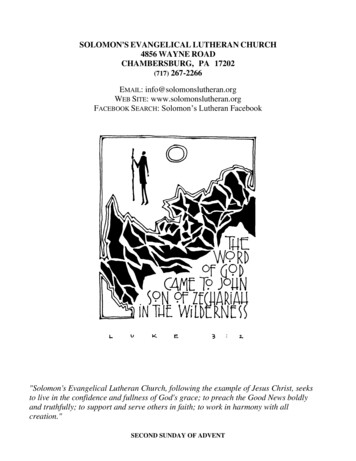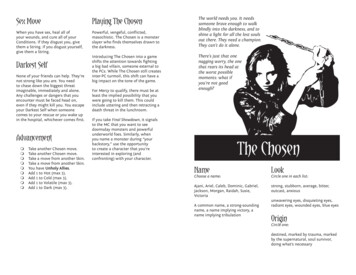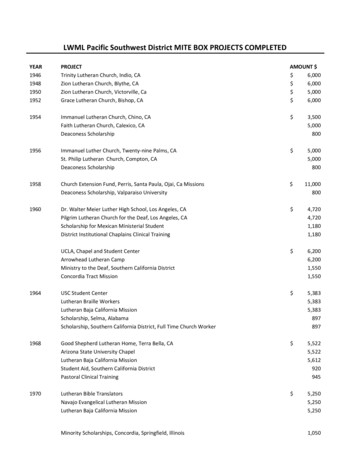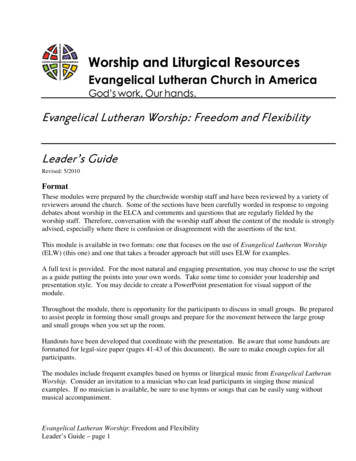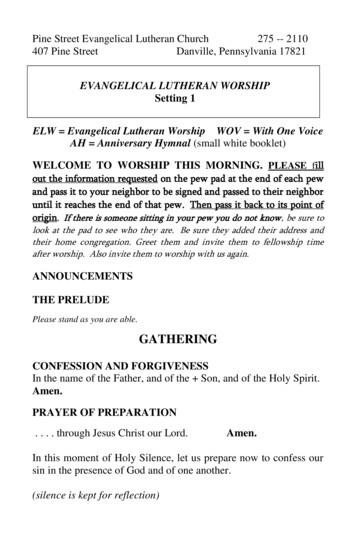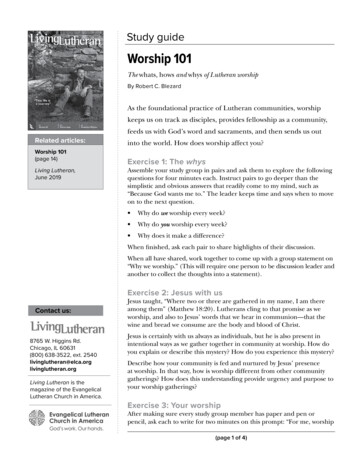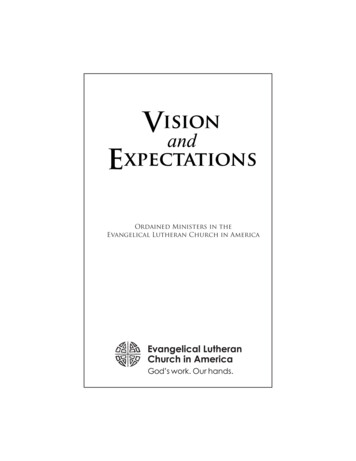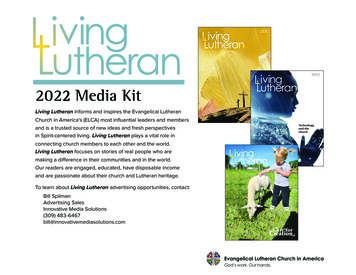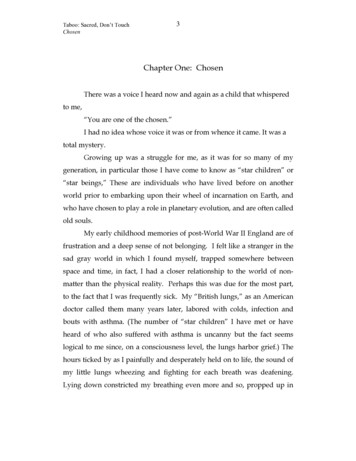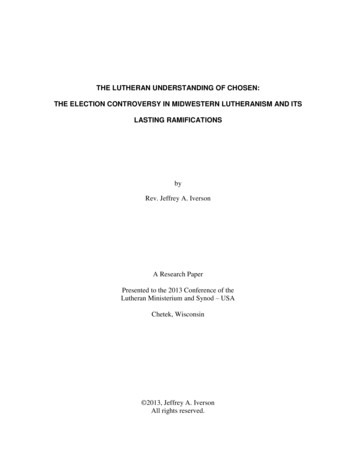
Transcription
THE LUTHERAN UNDERSTANDING OF CHOSEN:THE ELECTION CONTROVERSY IN MIDWESTERN LUTHERANISM AND ITSLASTING RAMIFICATIONSbyRev. Jeffrey A. IversonA Research PaperPresented to the 2013 Conference of theLutheran Ministerium and Synod – USAChetek, Wisconsin 2013, Jeffrey A. IversonAll rights reserved.
INTRODUCTIONThe Election Controversy touched all of the Lutheran church bodies in the United States,but was felt most strongly among those in the Midwest. It generally pitted the recent Midwestimmigrants of a more doctrinally orthodox Lutheran persuasion against those who were eitherless orthodox, or whose orthodoxy was more of a pietistic bent. It generally set synod againstsynod, but one group, the Norwegian Synod, was split asunder.When Norwegian immigrants in the mid-nineteenth century began to form Lutheranchurches in America, two distinct approaches to church life emerged. Some followed the morepietistic tradition of the Norwegian lay-evangelist Hans Nielsen Hauge and eventually formedHauge’s Synod. Another group patterned itself after the state-church of Norway and formed theNorwegian Synod. The Norwegian Synod found natural allies in the Lutheran Church MissouriSynod, led by the great theologian C.F.W. Walther. The Missouri Synod, the Norwegian Synod,the Ohio Synod, the Illinois Synod, the Minnesota Synod, and the Wisconsin Synod formed achurch fellowship called the Synodical Conference in 1872.The Ohio Synod left the Synodical Conference over the Election Controversy, as did theNorwegian Synod. A group calling itself the “Anti-Missouri Brotherhood” split from the Norwegian Synod in 1887. Pulling together some smaller groups, the Anti-Missouri Brotherhoodformed the United Church in 1890, mixing elements of both orthodox and pietistic groups. In1917, the Norwegian Synod, the United Church, and Hauge’s Synod merged to form the Norwegian Lutheran Church, uniting most Norwegian-American Lutherans in a single church body.The merger was facilitated by the “Madison Agreement” of 1912 which had effected an understanding on the doctrine of election, the issue which had precipitated the schism in the Norwegian Synod in the 1880s.How did this merger of such divergent views come to pass? Was it a true meeting of theminds, or was it an agreement to disagree? Was it union or unionism? The answer to these questions still has an effect on American Lutheranism today.
3I.THE MISSOURI SYNODThe Evangelical Lutheran Synod of Missouri, Ohio, and Other States (Missouri Synod)was founded in Chicago in April 1947. It drew together the Saxon immigrants who had settled inPerry County and St. Louis, MO and churches led by missionaries sent from Germany by JohannLoehe. The Missouri Synod was led by C.F.W. Walther, who came to lead that body after its firstleader, Martin Stephan was accused of misconduct.Walther was a keen theologian who went on to lead the Missouri Synod’s ConcordiaSeminary in St. Louis for many years and was a key player in the Election Controversy. AfterWalther’s death, Franz Pieper, author of the still-used three volume Christian Dogmatics, tookup the mantle as Missouri’s lead theologian.The Missouri Synod became the prime mover in the creation of the Synodical Conferenceand Walther was elected its first president.In 1880, one of the many groups that used the name “Illinois Synod” merged into the Illinois District of the Missouri Synod.II.THE IOWA SYNODThe Evangelical Lutheran Synod of Iowa and Other States (Iowa Synod) was formed in1854, primarily by Loehe men who disagreed with Walther on the doctrine of the ministry. Thelead theologian of the Iowa Synod was Gottfried Fritschel. The Iowa Synod became a one of themain opponents of Missouri in the Election Controversy, as well as on several other theologicalissues, including Chiliasm (millennialism).Because of its differences with Missouri, Iowa never joined the Synodical Conference. Itbecame friendlier with the Ohio Synod after that body left the Synodical Conference and eventually merged with the Ohio and Buffalo Synods to form the American Lutheran Church in 1930.
4III.THE OHIO SYNODThe Joint Synod of Ohio was formed in 1818 by the former Ohio Conference of the oldLutheran Ministerium of Pennsylvania. The Joint Synod of Ohio began under the influence ofthe confessionally lax “American Lutheranism” of the English-speaking eastern Lutherans, butunder the influence of W. F. Lehman of the synodical seminary at Columbus, became more andmore orthodox. In 1872, the Joint Synod of Ohio joined the Synodical Conference. It was tobreak with the Synodical Conference and Missouri in 1881 over the Election Controversy, amere three years after awarding C.F.W. Walther an honorary Doctor of Divinity. In 1930 itjoined with the Iowa Synod and the Buffalo Synod to form the American Lutheran Church.IV.THE WISCONSIN SYNODThe Wisconsin Synod was founded by three graduates from Germany of the Barmen missionary school in 1849. Like Ohio, Wisconsin began with a laxer form of Lutheranism, but grewto a more confessional stance under the leadership of Adolf Hoeneke.The Minnesota Synod was founded in 1860 by J. Heyer and other pastors who had migrated from Pennsylvania.In Michigan, a group known as the “Mission Synod” or Michigan Synod was formed in1860.The Wisconsin, Minnesota, and Michigan Synods joined the Synodical Conference in1872. These three synods began a tight working relationship in 1892 and in 1917 functionallyunited into Evangelical Lutheran Joint Synod of Wisconsin and Other States. The name waschanged to the Wisconsin Evangelical Lutheran Synod (WELS) in 1959.
5V.THE NORWEGIAN SYNODSubstantial numbers of Norwegian immigrants began arriving in the United States in the1840s when the Midwest was opening up for settlement. They first settled in northern Illinoisand in southern Wisconsin. From there, Norwegian settlement eventually expanded throughoutWisconsin, Iowa, Minnesota, and the Dakotas.Among the Lutheran Norwegians, two distinct approaches to church life appeared. Thefirst inherited the pietist heritage of Hans Nielsen Hauge (1771-1824), a Norwegian revivalistwho emphasized lay preaching, conversion, and sanctification. The second trend inherited thetraditions of the state Church of Norway, with a greater emphasis on an educated clergy, a formalliturgy, and doctrinal clarity. It is, however, extremely important not to carry these caricaturestoo far. Most Norwegians, lay and clergy alike, were neither “mindless” enthusiasts nor “heartless” orthodox dogmaticians. Most blended, to greater and lesser degrees, elements of both thesetraditions as taught by Professor Gisle Johnson at the University of Christiana (later Oslo).After a couple of false starts, the Norwegian Synod was formally organized in 1853 atLuther Valley in Wisconsin. Its first president (1853-62) was A.C. Preus (1814-78), who returned permanently to Norway in 1872. His cousin, H(erman) A(mberg) Preus (1825-1894),succeeded him as the second president of the Synod (1862-1894).From its founding, the Synod encompassed individuals whose sympathies were with thesecond group described above, i.e. they were sympathetic to a more formal ecclesiology andwere strongly concerned with maintaining a confessional Lutheran doctrine. These characteristics led the Synod to cordial relationships and formal affiliations with the like-minded MissouriSynod.To train its pastors, the Synod established a Norwegian professorship at Missouri’s Concordia Seminary in St. Louis. The position was initially filled by Pastor Laur. Larsen in 1859.Larsen left the post in 1861 when the seminary closed during the Civil War and went on to become one of the founders and the first president of Luther College. The position at Concordiaremained unfilled until 1872 when it was filled by F(riedrich) A(ugust) Schmidt (1837-1928)who remained there until the Synod opened its own seminary, Luther Seminary, in Madison in1876.
6Confessional crises among the eastern Lutherans in the 1860’s, and dissatisfaction withthe resulting synods, led the Midwestern Lutherans to form the Synodical Conference in 1872.They wrote:We would have preferred to join one of the existing associations . if this had been possible forour conscience which is bound by the word of God and whose duty lies in the most strict faithfulness to our confession.1In the Synodical Conference, the Norwegian Synod joined with the Joint Synod of Ohio, and theWisconsin, Illinois, Minnesota, and Missouri Synods.The first twenty-five years of the Norwegian Synod’s existence were something of whichto be proud. Nelson and Fevold write:In the year of its founding, 1853, it numbered but six pastors serving thirty-eight congregationswith an estimated membership of 11,400. By the time of its twenty-fifth anniversary, 1878, it hadgrown to the point where it numbered 137 pastors, 570 congregations, and 124,367 souls.after a quarter century, the Synod pastors could look at their church and conclude that it was remarkably united in its point of view. 2But this unity did not last long.VI.THE ELECTION CONTROVERSYThe theological debate over the doctrine of election or predestination did not begin withLutherans in 19th century America. The church father Augustine of Hippo (354-430) taught adoctrine of double predestination where God elects the elect and damns the damned. He waschallenged by a British theologian Pelagius (ca. 354 – ca. 420) who taught that man was not totally depraved and could freely choose salvation. Pelagianism was condemned by Council ofEphesus in 431. A milder form known as semi-Pelagianism arose that taught that man must cooperate with God’s grace to be saved. This, too, was condemned by the Synod of Orange in1“Justification for Synodical Conference, 1871” in Richard C. Wolf, Documents of Lutheran Unity in America.Philadelphia: Fortress Press, 1966, p. 190.2E. Clifford Nelson and Eugene L. Fevold, The Lutheran Church Among Norwegian Americans, Volume I, 18251890, Minneapolis: Augsburg Publishing House, 1960, p. 188 .
7529, though it later became the position of the Roman Catholic church and was the position espoused by Erasmus in his debate with Luther.Erasmus expounded his position in a 1524 treatise to which Luther responded with hiswell-known De Servo Arbitrio, known in English as the Bondage of the Will. Luther’s view approaches double predestination at times, but never really gets there. The Lutheran view becameknown as “single-predestination,” wherein God elects the saved by his grace, but the damned arecondemned by themselves. Luther believed this is what Scripture teaches and we are not to delveinto seeming contradictions that our human reason cannot resolve. Luther always emphasizesthe grace of God and the work of Christ.The so-called “Reformed” tradition also battled over the issue of election. John Calvin(1509-1564) emphasized the sovereignty of God and double predestination. Arminus (15601609) espoused a semi-Pelagianism where the elect cooperated in their salvation.Luther’s protégé Philip Melancthon (1497-1560) in the first edition of his Loci Communes Theologici (1521) espoused Luther’s view, but throughout his life he moved toward a cooperative or “synergistic” view. A controversy over election arose among Lutherans after Luther’s death between the so-called “Phillipists” and the “Genesio (true)” Lutherans. The theologian Martin Chemnitz espoused a view on election which leaned toward the Genesio side andwas incorporated into the Formula of Concord, Article XI, in 1577. A copy of this article fromthe Epitome of the Formula of Concord is attached in Appendix B.Concerning the Election Controversy of the nineteenth century, Eugene Fevold writesthat “It is somewhat unexpected that the Lutheran church should have been so thoroughly disturbed by a conflict that is not central to Lutheran teaching.”3 I disagree with this assessment inthat two very important principles of the reformation, sola gratia (by grace alone) and sola fide(by faith alone), converge in the doctrine of election, or predestination. If any doctrine is stated(or understood) in such a manner that these two principles seem to conflict, fireworks are boundto happen. The disagreement took shape over whether the Latin phrase intuitu fidei (in view offaith) was the term best suited to describe the doctrine.3Eugene L. Fevold, “Coming of Age, 1875-1900,” in E. Clifford Nelson, ed., The Lutherans in North America,Philadelphia: Fortress Press, 1980, p. 314.
8According to Edward Busch, the phrase intuitu fidei was commonly used by 17th centuryLutheran orthodox theologians such as Jacob Andrea, John Gerhard, John Quenstedt, and JohnBaier.4 C.F.W. Walther (1811-1887) looked rather to the Formula of Concord and to the earlierdogmaticians of the 16th century. Walther apparently became more and more convinced that theterm was not proper. In 1872, Walther wrote “the expression God has elected ‘in view of faith’ isan infelicitous term.”5 The matter more or less entered a more public forum in 1877 at a meetingof the Western District of the Missouri Synod where it was stated:God foresaw nothing, absolutely nothing, in those whom he resolved to save, whichmight be worthy of salvation, and even if it be admitted that He foresaw some good in them, this,nevertheless, could not have determined Him to elect them for that reason; for as the Scripturesteach, all good in man originates with Him. 6By 1880, Walther was writing that intuitu fidei was a term introduced by Aegidius Hunnius(1550-1603) and that:Those who, in harmony with our confession, and with a Luther, an Rhegius, a Chemnitz, a Kirchner, and others, deny that election has occurred intuitu fidei teach so much more positively that theelect have from eternity been chosen or ordained for justification and salvation by grace alone,through faith alone, and on account of the most holy merit of Christ.7The phrase intuitu fidei had developed among the dogmaticians as a defense against theCalvinist doctrine of “double predestination.” So when Walther dismissed the term, the obviousreaction among many was to accuse Walther of Calvinism. Walther’s dismissal of this term alsocaused a particular problem for Norwegians. Erik Pontoppidan’s (1698-1764) Sandhed til Gudfrygtighed (Truth unto Godliness), an explanation of Luther’s Small Catechism, had used similarlanguage to describe election. Pontoppidan’s work, while having no official status, had longbeen used for catechetical instruction in Norway and was widely revered by all Norwegian Lutherans.In the Norwegian Synod, Prof. F. A. Schmidt took up the anti-Walther position. Schmidthad been a student and colleague of Walther. Though of German background, he became fluentin Norwegian and taught at Luther College in Iowa. When the Norwegian Synod arranged toteach their pastors at Concordia Seminary in St. Louis, Schmidt was assigned a Norwegian pro4Edward Busch, “The Predestination Controversy 100 Years Later,” in Currents in Theology and Mission, June1982, pp. 132-133.5quoted in Busch, p. 135.6Minutes, quoted in Eugene L. Fevold, “Coming of Age, 1875-1900,” The Lutherans in North America, p. 317.7C.F.W. Walther, “Election is not in Conflict with Justification” in Lutheran Confessional Theology in America1840-1880, Theodore Tappert, ed., New York: Oxford University Press, 1972, p.201.
9fessorship there in 1872. When the Norwegian Synod opened its own seminary in Madison, WIin 1876, Schmidt was called to teach there. He hoped to be called to Concordia in his own right,but Walther refused him. Many speculate that this personal grudge fueled his growing hatred ofWalther and the Missouri Synod and that the Election Controversy was a convenient foil becauseas late as 1878 Schmidt had defended Walther’s position on election.8In 1880 Schmidt began publishing a theological journal called Altes und Neues to supporthis position. Schmidt was particularly quick to label his opponents as Calvinists. Schmidt andhis fellow professor H.G. Stub, along with U.V. Koren, B.J. Muus, and two others were the Norwegian Synod delegates to the 1882 Chicago convention of the Synodical Conference. Foursynods remained in the conference, Ohio having left earlier over its disagreements with Waltherand Illinois having merged into Missouri. Three of these, Minnesota, Wisconsin, and Missouriprotested the seating of Schmidt because of his public charges of Calvinism against them.Schmidt refused to answer U.V. Koren’s question about whether he came to the convention as afriend or foe. After four days of deliberations, four of the five Synod delegates joined the othersin voting against Schmidt. Only Muus supported him.9 It appears that Schmidt’s belligerent attitude turned even most of his colleagues against him. Even so, the Synod’s leadership was charitable to Schmidt. To avoid further confrontations, the Synod voted in 1883 to withdraw from theSynodical Conference.Schmidt and his growing anti-Missourian party continued to agitate within the Synod.Pastors were forced to resign their congregations by anti-Missourians. Yet, the Synod leadershipremained conciliatory. Pastor U.V. Koren presented to the General Pastoral Conference meetingin Eau Claire in 1884 a set of 63 theses termed An Accounting to the Congregations of the Norwegian Synod (known in Norwegian as “En Redegjoerelse” or “An Accounting”).10 Koren vehemently repudiates the charges of Calvinism and often quotes Pontoppidan. He goes on tostate:That presentation which limits election to the bare decree concerning salvation and whichexcludes from it God’s decree concerning the way and means of salvation, we do not acknowledge8John M. Brenner, The Election Controversy Among Lutherans in the Twentieth Century, Marquette University Dissertation, 2009, p. 79.9Theodore A. Aaberg, A City Set on a Hill, Mankato, MN: Board of Publications, Evangelical Lutheran Synod,1968, pp. 30-31.10The entire text of An Accounting is translated and reprinted in Lutheran Synod Quarterly, vol. XXXIII, no. 2, June1993, pp. 8-27.
10as the presentation of Scripture and the Formula of Concord (XI, 6 and 9). However, so long asthe doctrine of sin and grace is kept pure, we do not regard anyone who has used, or uses, that incomplete concept of election as a false teacher. Therefore we acknowledge, not indeed as a complete definition of the concept of election, but still as a correct presentation of the last part of it, theanswer given to Q. 548 of Pontoppidan’s Sandhed til Gudfrytighed, which reads: “That God hasappointed all those to eternal life whom He from eternity has seen would accept the grace proffered them, believe in Jesus and persevere in this faith unto the end (Rom. 8:28-30)” (2 Tim.1:13).This is to be understood in the manner in which it is developed by John Gerhard.Therefore, we declare also that we stand in fellowship of faith with those who like Pontoppidan and John Gerhard teach correctly regarding sin and grace and who, like them, reject thedoctrine that God has been influenced in electing men by their conduct. 11U. V. Koren, whom Clifford Nelson called “the keenest of the Synod dialecticians”12 had in 1884said “we stand in fellowship of faith with those who like Pontoppidan and John Gerhard.” This,in many ways, foreshadows what is said in the Madison Agreement of 1912.While the Synod leaders struck what may be called a tolerant position, Schmidt took aneven more intransigent stance. In response to Koren’s Accounting Schmidt writes:I believe and teach now as before, that it is not synergistic error, but a clear teaching of God’sWord and our Lutheran Confession that ‘salvation in a certain sense does not depend on Godalone’13At an October 1885 meeting the Anti-Missourians resolved that pastors who had signed An Accounting should be removed from office and that Pres. B. Harstad of the Minnesota District, andPres. U.V. Koren of the Iowa district should be removed from office.14 Once again it seems thatthe stereotypes of the rigid Synod dogmaticians have been misplaced.Schmidt did not teach in the 1885-86 school year and in 1886 the Anti-Missourians established their own seminary at St. Olaf’s school in Northfield, Minnesota, which began classes inthe fall of 1886. The schism was a fait accompli and in 1887-88 nearly one-third of the Synodleft to form the Anti-Missourian Brotherhood. In 1890 the Brotherhood joined with two smallergroups, the Norwegian Augustana Synod and the Norwegian Danish Conference, to form theUnited Norwegian Lutheran Church, the Synod’s main sparring partner in the next round of merger negotiations.11U.V. Koren, An Accounting (III, 13), Lutheran Synod Quarterly, vol. XXXIII, no. 2, June 1993, pp. 19-20.E. Clifford Nelson, The Lutheran Church Among Norwegian Americans, Volume II, 1890-1959, Minneapolis:Augsburg Publishing House, 1960, p.134.13Quoted in Aaberg, p. 36.14Aaberg, p. 37, Nelson-Fevold, vol I, p. 267.12
11VII.PRELUDE TO MERGER OF THE NORWEGIAN-AMERICAN LUTHERANSThe United Church suffered two small schisms in the first few years of its existence. Thefirst developed over a controversy surrounding Augsburg Seminary. Augsburg had been theseminary of the Norwegian-Danish Conference and was designated to be the official seminary ofthe new United Church. A controversy arose over the ownership of the school and the role of itscollege vis-a-vis St. Olaf. Supporters of Augsburg formed a group known as the "Friends ofAugsburg" and in 1897 split off to form the Lutheran Free Church. In 1900, a small group ofpersons caught up in a revival movement split from the United Church to form the Church of theLutheran Brethren.It was also in 1900 that the Norwegian Synod issued an invitation “inviting the presidentsand the theological faculties of the United Church and Hauge's Synod to a colloquy on doctrine.”15 The dominant feeling among many in the United Church and most in the Synod wasthat doctrinal agreement was a necessary prerequisite to closer fellowship.The United Church accepted the offer and the group met in March 1901. Once again itappears that F.A. Schmidt was a cause of contention. Nelson writes:the synod presidents and professors gave evidence of reaching a common view of the assurance ofsalvation based upon the theses presented by President Hoyme [of the United Church]. Thereuponresolutions were adopted to continue the discussions the next year. Previous to the next meeting,however, Professor F.A. Schmidt had published a partial account of the proceedings. As this wascontrary to the wishes of the colloquy and since Schmidt described Hoyme's theses as a 'compromise to bridge the chasm between truth and error,' the Synod passed a resolution in 1902, requesting the United Church to replace Schmidt with another man who was less likely to be 'a hindrance'to the cause of union. This the United Church refused to do; consequently no further discussionswere held.16Despite this, Nelson writes one page later “The United Church, committed to the task of furthering the cause of bringing all Norwegian Lutherans under one ecclesiastical roof, had seeminglyexhausted every possibility of rapprochement.”17 It seems to me that quelling the voice of someone as cantankerous as their own Schmidt would have been a step to try. In fact, this had to bedone before the Madison Settlement could become reality (see below).In 1905, Hauge's Synod issued a new call for church union. Committees from Hauge'sSynod, the Norwegian Synod and the United Church began meeting in 1906. Over the next three15E. Clifford Nelson, The Lutheran Church Among Norwegian Americans, Volume II, 1890-1959, p. 134.ibid., pp. 139-40.17ibid., p. 141.16
12years, agreement on theses regarding absolution, lay activity, the call, and conversion were readily reached, but a deadlock was developing again over the doctrine of election.VIII.THE MADISON AGREEMENTThe union committees labored over the doctrine of election from 1908 to 1910. In 1908 asubcommittee was named to prepare a set of theses on the issue of election. The subcommitteewas unable to agree on a common proposal so two members, Prof. John Kildahl (1857-1920),president of St. Olaf College of the United Church, and H(ans) G(erhard) Stub (1849-1931), professor at Luther Seminary and vice-president of the Norwegian Synod, each prepared a set oftheses for discussion. Stub's theses were selected for discussion by the union committee on thetie-breaking vote of the chairman, Carl Eastvold (1863-1929) of Hauge's Synod.Discussion of Stub's theses proved fruitless. A second subcommittee was asked again toprepare a joint declaration. It was resolved that if the subcommittee failed, the joint committeewould no longer meet. Once again the subcommittee was unable to agree on a set of theses fordiscussion. Despite this, a committee of the whole met in March 1910. The United and Haugemembers joined together to support the discussion of a set of theses prepared by presidentEastvold. The representatives of the Norwegian Synod left the meeting. Synod district meetingsthat year approved Stub's theses, but still holding out hope for the merger discussions, most werecareful to state that the intuitu fidei form of election need not be divisive:1. The Synod recommends that the Union Committee of the Norwegian Synod, the United Churchand Hauge’s Synod continue its work as long as it has any hope that unity on the basis of truth canbe attained.3. It (the Synod) also declares that the two doctrinal forms of election set forth in the confessionsof the Lutheran Church and by John Gerhard should not be regarded as schismatic, and wouldmuch deplore if that should be the case. 18Once again, the position of the Synod was conciliatory. However, in his address to the 1910convention of the United Church, President T.H. Dahl (1845-1923) “charged the Synod theses18Report of the Norwegian Synod, 1910, quoted in Evangelical Lutheran Church, The Union Documents of theEvangelical Lutheran Church, Minneapolis: Augsburg Publishing House, 1948, p 11.
13(Stub's) with being unbiblical and un-Lutheran.”19 A second union committee meeting in December that year ended with the same result as the March meeting: the committee voted to discuss Eastvold’s theses and the Synod representatives left. It appeared that merger discussionswith the Synod were over.Now, as in the 1880s, the Norwegian Synod seems to be willing to say that the intuitufidei expression of election need not be divisive of church unity. It appears that throughout thislong controversy the opinion and personality of one man, F.A. Schmidt, played a decisive anddivisive role. Even Nelson admits:Unfortunately, F.A. Schmidt of the United Church continued to accuse the Synod of Calvinism atevery turn. Schmidt could not forget that he was no longer back in the nineteenth century. On occasion, he acted as though he were still fighting Walther. It must be admitted that the presence ofSchmidt on the union committee and the hesitation of his colleagues to silence him or to apologizefor his occasional inexcusable outbursts played no little part in the cooling union interest amongthe leaders of the Synod.20Heretofore, most of the members of the union committees had been men who were theologians and/or church leaders, who, many will say, were overly concerned about doctrinal minutia and, as Nelson notes, were still fighting the 1880 battles over election. The impasse on election was first breached when the 1911 meeting of the United Church elected an entirely new setof representatives to the union committee, Pastors Peder Tangjerd, Gerhard Rasmussen, S.Gunderson, H. Engh, and M.H. Hegge. The Synod responded in a like manner by electing Pastors J. Norby, R. Malmin, J.E. Jorgensen, G.T. Lee, and I.D. Ylvisaker as their representatives.The Hauge Synod chose to remain out of any further negotiations on the doctrine of election,feeling that the issue concerned a standing disagreement between the other two bodies and confident that a resolution acceptable to both would be acceptable to it.On February 22, 1912, the union committee meeting in Madison, Wisconsin announcedthat it had reached an agreement on the doctrine of election. The “Madison Agreement” of 1912basically stated that there exists one doctrine of election which may be stated in two different“forms:”1. The Union Committees of the Synod and the United Church, unanimously and withoutreservation, accept that the doctrine of election which is set forth in Article XI of the Formula of1920ibid., p. 157.ibid., p. 167.
14Concord, the so-called First Form, and Pontoppidan’s Truth unto Godliness (Sandhed til Gudfrygtighed), question 548, the so-called Second Form of Doctrine. 21The Madison Agreement (or Opgjør as it was known in Norwegian) has been subject tomany historical interpretations. Fred Meuser calls it “a compromise which the former committeeof theologians would never have proposed.”22 O.G. Malmin, whose father Rasmus Malmin hadbeen on the Union Committee writes that Opgjør was:admittedly a compromise, yet it established the fact which should not have been lost sight of during the controversy, that the doctrine of Election can be stated in more than one way, and that boththe ways current in Lutheranism are acceptable.23Clifford Nelson sums it up this way:The Opgjør itself can best be described as the instrument of an ecclesiastical rapprochementrather than an astute and flawless display of theological finality with regard to the doctrine of election. Both sides, eager for union and weary of conflict, sought desperately to find a way in whichthey could be delivered from the clutch of bitterness and each could join the other without givingup his own views. It was a case of the victory of the heart over head.24All reports indicate that the announcement of the Madison Agreement was received bythe Norwegian-American community with a great deal of joy. At the same time however, theMadison Agreement created misgiving
THE LUTHERAN UNDERSTANDING OF CHOSEN: THE ELECTION CONTROVERSY IN MIDWESTERN LUTHERANISM AND ITS LASTING RAMIFICATIONS by Rev. Jeffrey A. Iverson A Research Paper Presented to the 2013 Conference of the Lutheran Ministerium an
